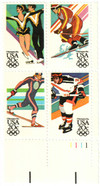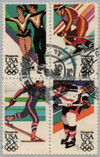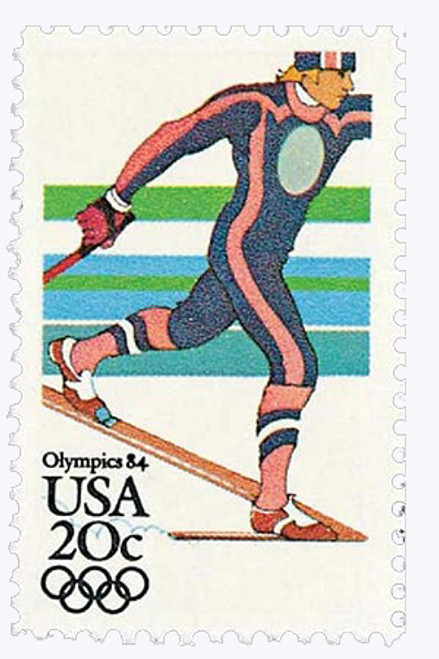
# 2067-70 - 1984 20c 14th Winter Olympic Games
U.S. #2067-70
1984 20¢ 14th Winter Olympic Games
- Issued to mark the 1984 Winter Olympic Games
Stamp Category: Commemorative
Set: 14th Winter Olympics (1984)
Value: 20¢, rate for first-class mail
First Day of Issue: January 6, 1984
First Day City: Lake Placid, New York
Quantity Issued: 316,925,000
Printed by: Bureau of Engraving and Printing
Printing Method: Photogravure
Format: Panes of 50 in Sheets of 200
Perforations: 10.5 x 11
Why the stamps were issued: The honor the athletes competing in the 1984 Winter Olympics Games.
About the stamp designs: Robert Peak designed these stamps in a similar style to previous Olympic stamps issued the year before. Each stamp has “flowing strikes” – colorful stripes adding movement to the background and definition to the uniforms and costumes. The stamps show a pair of ice dancers, a downhill skier, a cross-country skier, and a hockey player.
First Day City: These stamps were issued at the Lake Placid Resort Hotel, where the Biathlon national Championships and Olympic team tryouts were being held. The 1980 Winter Olympics had been held in Lake Placid four years earlier.
Unusual facts about these stamps: Between 1983 and 1984, the USPS issued 24 Olympics stamps to commemorate the 1984 Winter and Summer Games. This was more Olympic stamps than had been issued in the 50 years since Olympic stamps were first issued!
About Olympics Stamps: In 1932, the US Post Office Department issued its first stamp honoring the Olympics Games. 1932 marked the third time the Winter Olympic Games were held, and the first time the event was held in the US. The games were held in Lake Placid, a small town in upstate New York that was home to less than 3,000 year-round residents.
Less than five months later, the Post Office issued its second and third Olympics stamps, honoring the summer games. Both stamps were issued on June 15, 1932, in Los Angeles, California, the site of the games.
It would be nearly 30 years before the US issued another stamp honoring the Olympics. That issue commemorated the 1960 Winter Olympics held in Squaw Valley, California. Since 1972, the USPS has issued stamps for most Summer and Winter Olympic Games.
Click here for lots more US and worldwide Olympics stamps.
History the stamps represent: The 1984 Winter Olympic Games opened in Sarajevo, Yugoslavia (now Bosnia & Herzegovina), on February 8, 1984. These were the first Winter Games – and the second Olympics – held in a communist state.
Sarajevo authorities had shown interest in hosting the Winter Olympics as early as 1970. For the 1984 games, they competed against Göteborg, Sweden, and Sapporo, Japan, for the honor of being host city. Sarajevo was ultimately selected and announced as the host city in 1978. The games would be the first Winter Olympics held in a socialist state and a Slavic-speaking country. They were the second consecutive Olympics held in such a country after the 1980 Summer Olympics in Moscow. Dozens of nations, including the US had boycotted the 1980 Olympics and the Soviet Union would boycott the 1984 Summer Games held in Los Angeles later in the year.
Sarajevo invested in new alpine ski slopes, an ice rink, a bobsled and luge track, a speed skating track, and ski jumps. They also improved their transportation network between sites. Readers of the local paper selected a wolf named Vučko as the official mascot.
The 14th Winter Olympic Games officially opened on Wednesday February 8, 1984. A total of 45,000 spectators were present for the performance which included hundreds of musicians and dancers from various regions of Yugoslavia. The Olympic flag was accidentally raised upside down during the opening ceremony.
The Sarajevo games featured great moments from both veterans and newcomers. British skaters Jayne Torvill and Christopher Dean – longtime favorites – earned the first (and so far, only) perfect score in the ice dancing competition. East German women continued their dominance in speed skating, winning nine of 12 medals. Lamine Gueye of Senegal, a first-time nation, was the first Black African skier to compete in the Winter Olympics.
It was a breakthrough year for American competitors as well. Twin brothers Phil and Steve Mahre won the gold and silver medals in the slalom ski event. Phil didn’t find out until after the race was over that his wife, Holly, had given birth an hour earlier.
More surprising was skier Bill Johnson’s performance. By 1984, Johnson had not yet distinguished himself in international competition. But after a race victory earlier in the year, Johnson predicted that he would win a gold medal in the alpine skiing event. The Oregon native backed up his words, as he beat Peter Muller of Switzerland for America’s first-ever gold medal in the event.
Marja-Liisa Hamalainen, a cross-country skier from Finland, was the only athlete at the games to win three medals. She actually won four of them – three gold and one bronze. She won all three individual cross-country events, with distances of 5, 10, and 20 kilometers, and helped the Finnish team win the bronze in the 5×4 kilometer relay race (teams of four racers, who each ski five kilometers).
A then-record 49 countries competed in these games, many for the first time. These were the first Winter Games for the British Virgin Islands, Egypt, Monaco, Puerto Rico, and Senegal. A total of 1,272 athletes (998 men, 274 women) competed, a jump from the 1,072 athletes from 37 countries that competed in the 1980 Winter Games. There were a total of 39 events in 6 sports and 10 disciplines.
The games ended on February 19 and were considered a success. The games helped to modernize Sarajevo and develop winter sports in Yugoslavia. The quality of life increased for many residents and the city hosted several athletic events. However, the Bosnian War and the Siege of Sarajevo in the early 1990s destroyed many Olympic venues, some of which were never rebuilt. Sarajevo eventually began to host some athletic events.
U.S. #2067-70
1984 20¢ 14th Winter Olympic Games
- Issued to mark the 1984 Winter Olympic Games
Stamp Category: Commemorative
Set: 14th Winter Olympics (1984)
Value: 20¢, rate for first-class mail
First Day of Issue: January 6, 1984
First Day City: Lake Placid, New York
Quantity Issued: 316,925,000
Printed by: Bureau of Engraving and Printing
Printing Method: Photogravure
Format: Panes of 50 in Sheets of 200
Perforations: 10.5 x 11
Why the stamps were issued: The honor the athletes competing in the 1984 Winter Olympics Games.
About the stamp designs: Robert Peak designed these stamps in a similar style to previous Olympic stamps issued the year before. Each stamp has “flowing strikes” – colorful stripes adding movement to the background and definition to the uniforms and costumes. The stamps show a pair of ice dancers, a downhill skier, a cross-country skier, and a hockey player.
First Day City: These stamps were issued at the Lake Placid Resort Hotel, where the Biathlon national Championships and Olympic team tryouts were being held. The 1980 Winter Olympics had been held in Lake Placid four years earlier.
Unusual facts about these stamps: Between 1983 and 1984, the USPS issued 24 Olympics stamps to commemorate the 1984 Winter and Summer Games. This was more Olympic stamps than had been issued in the 50 years since Olympic stamps were first issued!
About Olympics Stamps: In 1932, the US Post Office Department issued its first stamp honoring the Olympics Games. 1932 marked the third time the Winter Olympic Games were held, and the first time the event was held in the US. The games were held in Lake Placid, a small town in upstate New York that was home to less than 3,000 year-round residents.
Less than five months later, the Post Office issued its second and third Olympics stamps, honoring the summer games. Both stamps were issued on June 15, 1932, in Los Angeles, California, the site of the games.
It would be nearly 30 years before the US issued another stamp honoring the Olympics. That issue commemorated the 1960 Winter Olympics held in Squaw Valley, California. Since 1972, the USPS has issued stamps for most Summer and Winter Olympic Games.
Click here for lots more US and worldwide Olympics stamps.
History the stamps represent: The 1984 Winter Olympic Games opened in Sarajevo, Yugoslavia (now Bosnia & Herzegovina), on February 8, 1984. These were the first Winter Games – and the second Olympics – held in a communist state.
Sarajevo authorities had shown interest in hosting the Winter Olympics as early as 1970. For the 1984 games, they competed against Göteborg, Sweden, and Sapporo, Japan, for the honor of being host city. Sarajevo was ultimately selected and announced as the host city in 1978. The games would be the first Winter Olympics held in a socialist state and a Slavic-speaking country. They were the second consecutive Olympics held in such a country after the 1980 Summer Olympics in Moscow. Dozens of nations, including the US had boycotted the 1980 Olympics and the Soviet Union would boycott the 1984 Summer Games held in Los Angeles later in the year.
Sarajevo invested in new alpine ski slopes, an ice rink, a bobsled and luge track, a speed skating track, and ski jumps. They also improved their transportation network between sites. Readers of the local paper selected a wolf named Vučko as the official mascot.
The 14th Winter Olympic Games officially opened on Wednesday February 8, 1984. A total of 45,000 spectators were present for the performance which included hundreds of musicians and dancers from various regions of Yugoslavia. The Olympic flag was accidentally raised upside down during the opening ceremony.
The Sarajevo games featured great moments from both veterans and newcomers. British skaters Jayne Torvill and Christopher Dean – longtime favorites – earned the first (and so far, only) perfect score in the ice dancing competition. East German women continued their dominance in speed skating, winning nine of 12 medals. Lamine Gueye of Senegal, a first-time nation, was the first Black African skier to compete in the Winter Olympics.
It was a breakthrough year for American competitors as well. Twin brothers Phil and Steve Mahre won the gold and silver medals in the slalom ski event. Phil didn’t find out until after the race was over that his wife, Holly, had given birth an hour earlier.
More surprising was skier Bill Johnson’s performance. By 1984, Johnson had not yet distinguished himself in international competition. But after a race victory earlier in the year, Johnson predicted that he would win a gold medal in the alpine skiing event. The Oregon native backed up his words, as he beat Peter Muller of Switzerland for America’s first-ever gold medal in the event.
Marja-Liisa Hamalainen, a cross-country skier from Finland, was the only athlete at the games to win three medals. She actually won four of them – three gold and one bronze. She won all three individual cross-country events, with distances of 5, 10, and 20 kilometers, and helped the Finnish team win the bronze in the 5×4 kilometer relay race (teams of four racers, who each ski five kilometers).
A then-record 49 countries competed in these games, many for the first time. These were the first Winter Games for the British Virgin Islands, Egypt, Monaco, Puerto Rico, and Senegal. A total of 1,272 athletes (998 men, 274 women) competed, a jump from the 1,072 athletes from 37 countries that competed in the 1980 Winter Games. There were a total of 39 events in 6 sports and 10 disciplines.
The games ended on February 19 and were considered a success. The games helped to modernize Sarajevo and develop winter sports in Yugoslavia. The quality of life increased for many residents and the city hosted several athletic events. However, the Bosnian War and the Siege of Sarajevo in the early 1990s destroyed many Olympic venues, some of which were never rebuilt. Sarajevo eventually began to host some athletic events.

















